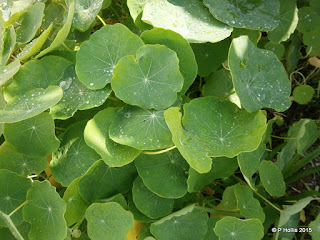I bet the title has you all puzzled and wondering
what on earth I am talking about?
The other day I was washing up and idly staring
out of the kitchen window. I do a lot of idle staring in one way or another,
but I multi-task and do a lot of my indepth thinking at the same time! This is
my view (actually I went outside to take the photo as the window is rather
grundgy and grubby and you have to screw your eyes up to see anything.)
 |
| A nasturtium jungle! |
And I happened to notice that the nasturtiums
that self-planted themselves from the mother plants that I had purposely
planted last year, were spreading and were rapidly getting out of control.
So I said to Rob 'I must pull out some of those,
they are taking over the garden and there's other stuff underneath them.' Then
I said 'It's a pity that you can't do something with them. I wonder if you can
make soup out of the leaves!' and he said (all together now…..) 'Google it!'
So I did, and yes you can!
I was amazed!
'The leaves of the Nasturtium can be used in a
variety of ways: as a spicy addition to salads, as the base for pesto, or
chopped and combined with softened cheeses for spreads. The leaves can be used
as beds for chicken salad or fish, and used as garnish atop savory muffins and
potato salad. Stuff Nasturtium leaves with rice and herbs for a take on Greek
dolmas. Add fresh leaves and blossoms to a vinegar solution, with a clove of
garlic and allow to sit for four to five weeks for a peppery, pungent vinegar for
salad dressings. Due to the fragility of the leaves and the aroma, Nasturtium
leaves and other cresses cannot be dried.' (Thanks to Google)
 |
| A healthy crop waiting to be picked for soup! Look at the water drops shining! |
Although they are considered a cress due to the
similarity of their oil to that of watercress, nasturtiums are in a genus all
of their own, namely Tropaeolum. And, of course, the seeds are often pickled
and used instead of capers. Real capers are actually the flower buds of the
Caper Bush, also known as Flinders Rose. (Isn't Google wonderful.........)
Anyway, back to the soup.
There are several recipes for Nasturtium Soup
listed, so I kind of gathered the ingredients from a few and came up with the
following recipe:
Melt about 2 tablespoons of butter in a saucepan
and gently cook one diced onion until soft but not brown. Add 2 peeled and
diced potatoes (not sure of the size) and 30 Nasturtium leaves, (after first
removing the stems and any bird poo or odd bugs that happen to be clinging on!)
Once the leaves have wilted, about 5 minutes, add 3 cups of chicken stock. Add
1 bay leaf, salt and pepper and simmer until the potatoes are tender, about 15
minutes. Remove the bay leaf, cool the soup and add a cup (more or less) of cream. Purée until
smooth. Heat gently when you want to serve and float a flower on each serving!! (Rob ate his flower......and mine!)
 |
| A swirl of cream and a delicately placed flower. |
Now, personally, I think cream is better than
milk, but some recipes listed milk and some said cream, so really it's up to
you.
And, why did I call this Nose Twister Soup?
Because the name 'nasturtium' comes from two Latin words, namely 'nas' (nose)
and 'tortum' (twist), so called because of a person's reaction after biting
into the peppery, bittersweet leaves!
And the flavour of the soup?
In one word..............
 |
| A picture paints a thousand words............... |
Delicious!

4 comments:
Well well well you live and learn! Love the nose twister bit, I did know that you can eat the leaves, flowers and seeds, but the soup is a new one on me. Pity our thriving nose twister patch has died!!
We were most impressed with it, it is definitely a 'do-again' dish, especially when/if I want to impress with my culinary skills.............
Because I always challenge the things I read:
"Nasturtium is a genus of seven plant species in the family Brassicaceae (cabbage family), best known for the edible watercresses Nasturtium microphyllum (Rorippa microphylla) and Nasturtium officinale (R. nasturtium-aquaticum).
The genus Nasturtium should not be confused with the flowering garden annual commonly known as nasturtium (Tropaeolum majus). Though not related, the leaves of the garden nasturtium also have a peppery taste."
So there are two different Nasturtiums (or Nasturtia?). Are they both edible?
Anyway, with now four cats around you should not only look for bird poo and bugs, perhaps you should also add something about that in your recipe.
Michael
The Nasturtium Officinale is not closely related to the garden variety and is known as Watercress here. It is classified as a Category 2 invasive plant and is a problem throughout South Africa as it invades rivers and wetlands. It is edible though and can be used in salads and garnishings! All very interesting and thanks again for your interesting comment. All cats are fine and settling down with each other! Hope your Boris is behaving! I just love that name!!
Post a Comment